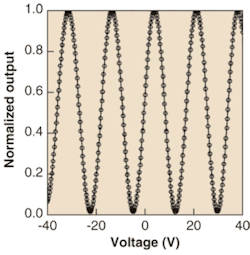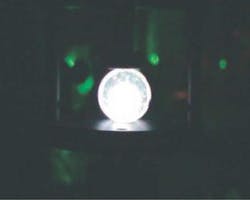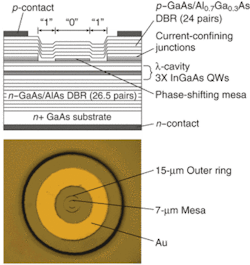Market seminar to explore nanophotonics, China, and more
“Real-world” opportunities in nanophotonics and the emerging industrial-laser market in China will be two of the highlights at the 15th annual marketplace seminar presented by Laser Focus World and Strategies Unlimited Jan. 24, 2005, in San Jose, CA. Renamed the Lasers and Photonics Marketplace Seminarto better reflect the changing marketplace, the seminar provides business leaders, investors, and technology analysts with the only applications-oriented review of worldwide laser markets, coupled with discussions of key business and technology trends.
In the keynote address Samuel Kahan, senior economist with the Federal Reserve Bank of Chicago’s Detroit Branch, will recap the key economic events of 2004 and outline the likely pattern of economic events in 2005. Additional presentations include a look at trends in medical-laser technologies by Robert Grant of Biolase; a review of low-power “solid-state” visible-laser technologies by entrepreneur Larry Marshall; an assessment of market sizes and technology trends in the graphic arts by Greg Niven of Coherent; and a look at next-generation lithography by Nigel Farrar of Cymer. For more information or to register, visit www.marketplaceseminar.com.
Quantum-dot laser has temperature-independent operation
Scientists at Fujitsu (Tokyo, Japan) and The University of Tokyo have demonstrated temperature-independent operation of p-type doped quantum-dot lasers between 20°C and 70°C at a wavelength of 1.3 µm with an extinction ration of 7 dB and a speed of 10‑Gbit/s, a typical rate used in today’s local- and metropolitan-area-network optical backbones, according to a presentation at the European Conference and Exhibition on Optical Communication 2004 (Stockholm, Sweden; Sept. 5-9). The research team was led by Yasuhiko Arakawa, director of the Nanoelectronics Collaborative Research Center at The University of Tokyo, and a member of the scientific advisory board of NL Nanosemiconductor (Dortmund, Germany), which was originally spun out of the Abram Ioffe Physical-Technical Institute (St. Petersburg, Russia).
The laser uses quantum-dot technology researched over the past 10 years under the direction of Zhores Alferov, head of the Abraham Ioffe Institute. The goal of Arakawa’s team is to develop by 2007 a laser product that will be smaller, less expensive, and operate at lower power than currently available devices. Contact Yasuhiko Arakawa at [email protected].
Mach-Zehnder modulator is molded from polymer
Electro-optic polymers are being explored for use in integrated optical circuits. Their low material dispersion allows electro-optic modulation bandwidths up to 1.6 THz. Using soft-stamp replica-molding lithography, scientists have fabricated Mach-Zehnder modulators from a chromophore-doped electro-optic polymer. Replica molding takes advantage of the plastic nature of electro-optic polymers and enables high-throughput fabrication, low setup costs, and replication of nanometer-scale structures over many square centimeters.
The fabricated Mach-Zehnder structures had a waveguide width and thickness of 4.5 and 2.6 µm, respectively, with a mold size of 3.8 × 1.8 cm and 2-cm-long interferometer arms with 1-mm S-shaped bend radii. Laser light at 1600 nm was fed through a polarizer and input to the cleaved and unpolished ends of the structure through a tapered fiber. The replica-molded device had an extinction ratio better than 19 dB and a half-wave voltage (the voltage required to switch the output from full-on to full-off) of 8.4 V-within a factor of two of commercial devices and easily improved by optimizing the poling efficiency and thinning the cladding layer. Shown here is the measured output as a function of applied voltage. Contact George Paloczi at [email protected].
Tabletop laser produces femtosecond x-ray pulses
Femtosecond soft-x-ray pulses will become valuable for research in structural biology and other areas. While some free-electron lasers (FELs) will provide these pulses, FELS are large, expensive, and uncommon. Researchers at the Laboratoire d’Optique Appliqueé and the École Polytechnique (both of Palaiseau, France), the Instituto Superior Técnico (Lisboa, Portugal), CEA/DIF (Bruyères-le-châtel, France), the Université Paris-Sud (Orsay, France), and CEA/SPAM (Gif-sur-Yvette, France) have developed a tabletop femtosecond x-ray laser that should make these pulses widely available.
A high-harmonic-generation seed is generated from 20-mJ 30-fs IR laser pulses focused in argon. A soft-x-ray-laser amplifier of krypton gas pumped with a 1-J 30-fs laser receives the pump pulses, producing 32.8nm pulses of approximately 500-fs duration and 0.7-µJ energy. If focused to a 0.1-µm spot, the pulses can reach 1.5 × 1016 W/cm2 peak intensity. The researchers are working to increase the pulse energy to 0.1 mJ or more and decrease pulse duration to 100 fs, possibly by using gas capillaries instead of gas cells. Ultimately, intensities of 1020 W/cm2 should be possible. Contact Phillipe Zeitoun at [email protected].
Interference technique characterizes ultrafast pulses
Researchers at the Georgia Institute of Technology (Atlanta, GA) have developed a method to completely characterize the electric field of a train of identical ultrafast light pulses, revealing their structure in three spatial dimensions as well as time. A pulse is split, with part filtered by a tunable narrowband filter and pinhole and part left alone; the two parts are interfered to find an individual complex Fourier component (detected by a CCD) at the narrowband filter’s frequency. Tuning the filter for other pulses produces other Fourier components, the relative phases of which are found by a frequency-resolved optical-grating measurement over a small portion of the beam chosen to contain all the frequency components.
A Ti:sapphire laser with a typical bandwidth of 40 nm was used for the experiment. Twenty measurements were taken using four different tilt-tuned narrowband filters. The researchers characterized pulses coupled in space and frequency (spatial chirp) and in space and time (pulse-front tilt). Results of the experiment were put in the form of a movie of a pulse approximately 1 mm in diameter that shows pulse-front tilt as well as spatial and temporal chirp. Contact Pablo Gabolde at [email protected].
Transparent silica material emits white light
In a quest to wring light from silica, researchers from Kobe University (Kobe, Japan) have created a nonporous bulk silica glass that, when excited by UV radiation, emits broadband white light. The glass and its emission are stable under prolonged exposure to the atmosphere and UV light. The mechanism for photoluminescence (PL) is different from those for silica nanoparticles and porous-silica materials.
Starting with silica nanoparticles of 7-nm size, the researchers compact the particles at 530 MPa into 20-mm-diameter, 1-mm-thick disks. Upon treating with 980°C heat for 100 h or more (optimum is about 192 h), the disks shrink to 15 mm in diameter and become nonporous and visually transparent. When excited by light anywhere from 200 to 300 nm in wavelength, the material emits over a 400- to 700-nm range; the shape of the PL spectrum is virtually independent of the selected UV excitation wavelength. The researchers attribute the PL to a one-photon excitation process associated with a weak absorption band below 300 nm. The researchers aim to determine the emission quantum yield of the material. Contact Takashi Uchino at [email protected].
Fabrication of mode-confined VCSEL is entirely epitaxial
Oxide-confined vertical-cavity surface-emitting lasers (VCSELs), while widely studied and manufactured, are limited in their reproducibility and reliability, problematic for dense integration, and subject to strain from the oxide itself due to the nonplanar crystal surface that results from the fabrication process. A new VCSEL-fabrication approach that provides low loss and simultaneous small-area mode confinement has been developed by researchers at the University of Texas at Austin (Austin, TX).
The method achieves mode confinement through placement of a phase-shifting mesa in a fully epitaxial cavity-an approach that enables intracavity patterning of the mode to control polarization or introduce two-dimensional gratings or photonics crystals. The phase-shifting mesa, only 7 µm in diameter and 125‑Å in height, is placed within a 15-µm-diameter current-confining aperture formed from backbiased p-n junctions. With a threshold current of 1.3 mA for a minimum optical mode size of 2.5 µm at a 980-nm emission, the all-epitaxial VCSEL (scattering parameter |C|2= 0.994) outperforms the oxide-confined VCSEL (scattering parameter |C|2 = 0.990). Contact D. G. Deppe at [email protected].
Perfect lens not possible with metamaterials
Until the development of metamaterials, the search for a “perfect lens” that could create an undistorted, aberration- and diffraction-free flat image of finite size was seen as an impossible task. Metamaterials are engineered composites that can exhibit a negative index of refraction (as well as negative dielectric permittivity and negative magnetic permeability) and are able to naturally focus diverging waves entering and passing through them (even without the use of curved surfaces), unlike their natural, positive-index material counterparts in which diverging electromagnetic radiation continues to diverge.
While metamaterials have been fabricated from engineered composites and are able to focus microwaves, researchers at Purdue University (West Lafayette, IN) and the Massachusetts Institute of Technology (Cambridge, MA) have shown through mathematical analysis that metamaterials still exhibit optical losses that preclude the formation of a “perfect lens.” However, their analysis also shows that positive- and negative-refractive-index materials can be used in combination to create superior lenses if the lens materials and geometry are optimized. Metamaterials that focus energy at optical wavelengths have not yet been developed, but are the subject of ongoing research. Contact Kevin Webb at [email protected].
Hybrid single-photon avalanche photodetector looks good for QKD
Quantum-key-distribution (QKD) systems over optical fiber represent an ideal encryption method: by using the polarization state of a photon as the key for encoding information, the Heisenberg uncertainty principle (which states that the position of a particle cannot be known without altering the state of the particle) makes it impossible for the eavesdropper to decode information without alerting the sender in the process. Unfortunately, single-photon sources and single-photon detectors are the bottleneck in QKD system performance; to date, single-photon detectors have suffered from high dark-count probability and low single-photon quantum-detection efficiency (SPQE).
In a step toward removing these bottlenecks, indium gallium arsenide on silicon (InGaAs on Si) avalanche photodiodes (APDs) have been created with a light-sensitive diameter of 150 µm that take advantage of the lower dark current, superior gain characteristics, and lower afterpulse effect as a result of lower trap density and trap energy in the Si multiplication region. Unlike their less-effective InGaAs/indium phosphide counterparts, the APDs on Si exhibited a dark-count probability of 10−4 to 10−3 and SPQE values of up to 33% at 1550 nm without antireflection coatings. Improved results are possible with optimization of the measurement conditions and device diameters. Contact Y. Kang at [email protected].


